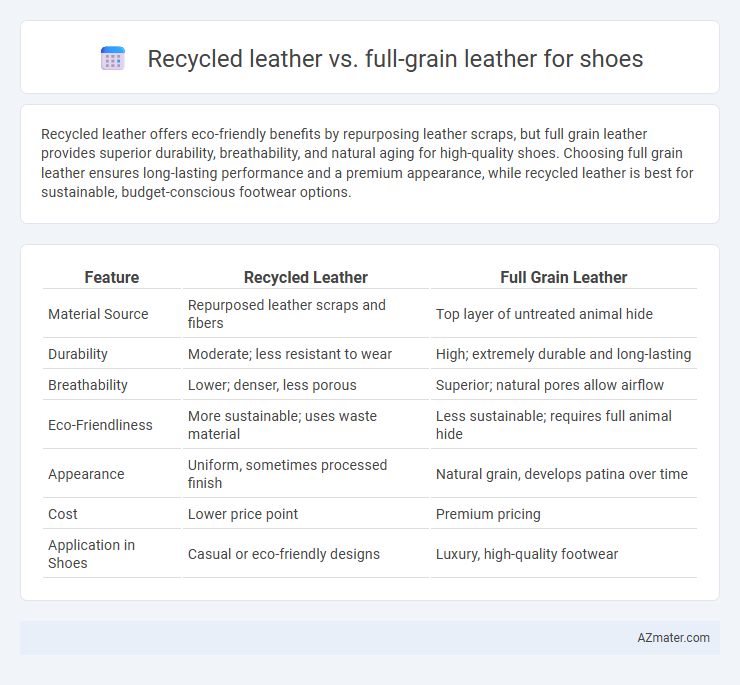Recycled leather offers eco-friendly benefits by repurposing leather scraps, but full grain leather provides superior durability, breathability, and natural aging for high-quality shoes. Choosing full grain leather ensures long-lasting performance and a premium appearance, while recycled leather is best for sustainable, budget-conscious footwear options.
Table of Comparison
| Feature | Recycled Leather | Full Grain Leather |
|---|---|---|
| Material Source | Repurposed leather scraps and fibers | Top layer of untreated animal hide |
| Durability | Moderate; less resistant to wear | High; extremely durable and long-lasting |
| Breathability | Lower; denser, less porous | Superior; natural pores allow airflow |
| Eco-Friendliness | More sustainable; uses waste material | Less sustainable; requires full animal hide |
| Appearance | Uniform, sometimes processed finish | Natural grain, develops patina over time |
| Cost | Lower price point | Premium pricing |
| Application in Shoes | Casual or eco-friendly designs | Luxury, high-quality footwear |
Introduction: Why Compare Recycled Leather and Full Grain Leather for Shoes?
Comparing recycled leather and full grain leather for shoes highlights key differences in durability, environmental impact, and aesthetic qualities. Full grain leather offers unmatched strength and natural texture, while recycled leather provides an eco-friendly alternative by repurposing leather waste. Understanding these distinctions helps consumers make informed choices based on performance and sustainability.
What is Recycled Leather?
Recycled leather is produced by shredding and re-bonding leftover leather scraps from manufacturing processes, offering an eco-friendly alternative to traditional materials. This material retains some genuine leather fibers combined with synthetic binders to create a sustainable yet durable option for shoe uppers and linings. In contrast to full grain leather, which uses the highest quality and most natural leather layer, recycled leather emphasizes waste reduction and resource efficiency while potentially sacrificing some breathability and longevity.
What is Full Grain Leather?
Full grain leather is the highest quality leather made from the top layer of the hide, retaining the natural grain and strength without any sanding or buffing. It offers superior durability, breathability, and develops a rich patina over time, making it ideal for premium shoes. Unlike recycled leather, full grain leather provides unmatched longevity and a natural, authentic look.
Durability: Recycled Leather vs Full Grain Leather
Full grain leather offers superior durability compared to recycled leather due to its intact natural fiber structure, which resists wear and tear over time. Recycled leather, made from shredded leather fibers combined with binders, tends to be less resilient and prone to cracking or peeling under heavy use. For long-lasting shoes, full grain leather remains the preferred choice as it withstands moisture, abrasion, and stretching far better than recycled leather alternatives.
Comfort and Wearability Differences
Recycled leather offers a softer feel due to its blended materials, but it generally lacks the breathability and durability of full grain leather, which provides superior comfort for long-term wear. Full grain leather develops a natural patina over time, enhancing flexibility and fit, while recycled leather tends to wear down faster and may show signs of cracking or peeling. For shoe wearability, full grain leather's robust structure supports better cushioning and moisture management, making it ideal for extended use.
Environmental Impact: Sustainability of Both Materials
Recycled leather reduces waste by repurposing scraps and offcuts, minimizing landfill contributions and lowering resource consumption compared to full grain leather, which requires extensive water, energy, and chemical use during tanning. Full grain leather offers durability and longevity, often outlasting recycled leather shoes, which can contribute to less frequent replacements and reduced environmental impact over time. Both materials present trade-offs in sustainability, with recycled leather promoting waste reduction and full grain leather supporting product longevity and biodegradability.
Aesthetic Appeal and Aging (Patina Development)
Recycled leather offers a uniform aesthetic with limited variation but lacks the rich texture and depth found in full grain leather, which develops a distinctive, attractive patina over time. Full grain leather ages gracefully as natural oils and wear create unique character and enhanced visual appeal, while recycled leather tends to show wear more quickly without evolving in appearance. The patina development in full grain leather contributes to its premium look and durability, making it a preferred choice for high-quality, long-lasting shoes.
Price Comparison: Affordability and Value
Recycled leather offers a more affordable price point compared to full grain leather, making it a budget-friendly option for shoe buyers. Full grain leather, known for its durability and premium quality, commands a higher price but provides long-term value due to its longevity and ability to develop a natural patina. Consumers seeking a balance between cost and quality often find recycled leather suitable for short-term use, while full grain leather remains the preferred choice for investment in durable, high-end footwear.
Maintenance and Care Requirements
Recycled leather requires less intensive maintenance compared to full grain leather, as it is often treated with protective coatings that enhance water resistance and reduce staining. Full grain leather demands regular conditioning and careful cleaning to maintain its durability and natural appearance, preventing cracking and drying out over time. Proper care routines for full grain leather, including using leather-specific cleaners and conditioners, significantly extend the lifespan of shoes made from this premium material.
Which Leather is Best for Shoes? Final Verdict
Full grain leather is widely considered the best choice for shoes due to its durability, natural breathability, and ability to develop a rich patina over time. Recycled leather offers an eco-friendly alternative by repurposing leather scraps, but it often lacks the strength and longevity of full grain leather. For long-lasting, high-quality footwear, full grain leather remains the superior option, while recycled leather suits those prioritizing sustainability with moderate durability.

Infographic: Recycled leather vs Full grain leather for Shoe
 azmater.com
azmater.com